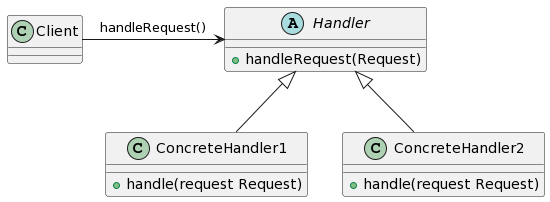1. What is the Chain of Responsibility Pattern
The Chain of Responsibility Pattern is a behavioral design pattern that decouples the sender and receiver of a request, allowing multiple objects the chance to handle the request. Each receiver contains a reference to another receiver, and if it cannot handle the request, it forwards the request to the next receiver until the request is handled or reaches the end of the chain.
2. Characteristics and Advantages of the Chain of Responsibility Pattern
The characteristics and advantages of the Chain of Responsibility Pattern are as follows:
- Decoupling of sender and receiver: The sender does not need to care about which receiver handles the request, nor does it need to know the specific handlers in the chain.
- Flexibility: It allows for dynamic addition, removal, or reordering of handlers in the chain without modifying the code of sender and receiver.
- Extensibility: Easy to extend the responsibility chain by adding new specific handlers.
- Single Responsibility Principle: Each specific handler only needs to care about its own handling logic.
- Configurability: The chain of handlers can be configured according to needs, allowing different requests to have different chains of handlers.
3. Examples of Practical Applications of the Chain of Responsibility Pattern
The Chain of Responsibility Pattern has many practical applications, such as:
- Request handling in web applications: It can be used to handle different types of requests, such as identity authentication, logging, and permission verification.
- Error handling: It can be used to handle errors, with each handler responsible for handling a specific type of error and forwarding the error to the next handler as needed.
- Event handling: It can be used to handle different types of events, such as user click events, network request events, and so on.
4. Implementation of the Chain of Responsibility Pattern in Golang
4.1 UML Class Diagram

4.2 Example Introduction
In the UML class diagram above, we have defined an abstract handler (Handler) and two concrete handlers (ConcreteHandler1 and ConcreteHandler2). The client (Client) initiates requests by calling the handleRequest method of the handler.
4.3 Implementation Step 1: Define the Abstract Handler Interface
type Handler interface {
HandleRequest(request Request) error
SetNext(handler Handler)
}
type Request interface {
Condition bool
}
The abstract handler interface defines the method HandleRequest for processing requests and the method SetNext for setting the next handler.
4.4 Implementation Step 2: Implementing Concrete Handler Classes
type ConcreteHandler1 struct {
next Handler
}
func (h *ConcreteHandler1) HandleRequest(request Request) error {
// Logic for handling the request
if request.Condition {
// Code for handling the request
return nil
} else {
if h.next != nil {
return h.next.HandleRequest(request)
}
return errors.New("No handler found")
}
}
func (h *ConcreteHandler1) SetNext(handler Handler) {
h.next = handler
}
type ConcreteHandler2 struct {
next Handler
}
func (h *ConcreteHandler2) HandleRequest(request Request) error {
// Logic for handling the request
if request.Condition {
// Code for handling the request
return nil
} else {
if h.next != nil {
return h.next.HandleRequest(request)
}
return errors.New("No handler found")
}
}
func (h *ConcreteHandler2) SetNext(handler Handler) {
h.next = handler
}
The concrete handler classes implement the abstract handler interface and override the HandleRequest and SetNext methods.
4.5 Implementation Step 3: Building the Chain of Responsibility
handler1 := &ConcreteHandler1{}
handler2 := &ConcreteHandler2{}
handler1.SetNext(handler2)
By instantiating the concrete handlers and setting the next handler, a chain of responsibility is built.
4.6 Implementation Step 4: Client Code
func main() {
handler := &ConcreteHandler1{}
// Building the chain of responsibility
handler.SetNext(&ConcreteHandler2{})
// Sending a request
handler.HandleRequest(Request{Condition: true})
}
In the client code, a concrete handler is instantiated, the next handler is set, and then the HandleRequest method is called to send a request.